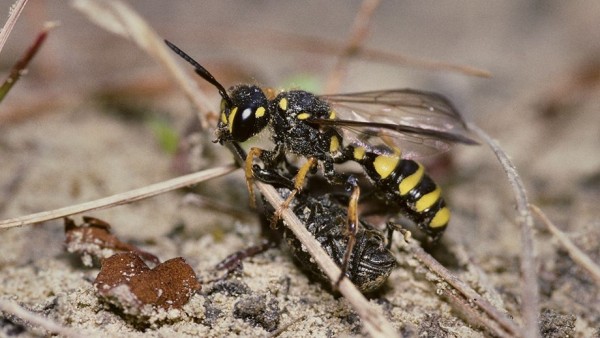By Ana Verayo, | February 16, 2016

A Cerceris arenaria wasp.
Scientists have now uncovered how wasps apparently possess an amazing view of the world, creating a new video that reveals how ground wasps perform a unique exercise of "looping in arcs" around their nest where it eventually gains height and distance before they fly away.
Like Us on Facebook
Wasps and other insects are also known to perform what biologists call "learning flights" before they leave their nests that involves repetitive loops around the nest area. Their return flights also appear similar to learning flight patterns in loops.
In this new study, scientists have determined how these special departure flights are helping wasps to improve their orientation and navigation back to their home after a day's foraging, but until these new findings, it was unclear how or why wasps do it.
For almost 10 years, scientists have been studying and examining this distinct flight behavior of the solitary ground wasp. These flight maneuvers are executed with precision with an exact pattern that are common to insect species that are learning to fly says co-author of the study, Jochen Zeil from the Australian National University.
Zeil describes this pattern as the wasps back away from the nest using a series of widening arcs where they pivot around as they look back in that direction. When the wasps are flying along these arcs, this becomes an advantage for the insects to view their entire nest environment from different directions and distances, where the nest will remain to their left or right visual field when they fly back home.
However, scientists want to see what the wasps are actually seeing during their flights so researchers used high speed cameras to capture the wasps' departure and return flights.
When the wasps leave and return back to their nests at the end of the day, scientists recorded their movements with video cameras that are synchronized with tracking software of the wasps' head positions, to visualize the direction of their sight.
Using a panoramic imager, researchers were able to capture their environment and create a 3D model of the wasp nest. This virtual wasp nest environment and a digital map of the wasp's position in mid air during flight were able to provide scientists a first person perspective of the wasp, not just its distinct flight pattern but also its point of view, from the point where they fly around the nest before venturing out to forage.
This new wasp virtual environment can now predict wasp flights as these new findings matched with actual return flight and orientation flight patterns, and also the wasps' behavior. Researchers also believe that this valuable data can be developed in new GPS system applications.
This new study is published in the journal Current Biology.
-
Use of Coronavirus Pandemic Drones Raises Privacy Concerns: Drones Spread Fear, Local Officials Say

-
Coronavirus Hampers The Delivery Of Lockheed Martin F-35 Stealth Fighters For 2020

-
Instagram Speeds Up Plans to Add Account Memorialization Feature Due to COVID-19 Deaths

-
NASA: Perseverance Plans to Bring 'Mars Rock' to Earth in 2031

-
600 Dead And 3,000 In The Hospital as Iranians Believed Drinking High-Concentrations of Alcohol Can Cure The Coronavirus

-
600 Dead And 3,000 In The Hospital as Iranians Believed Drinking High-Concentrations of Alcohol Can Cure The Coronavirus

-
COVID-19: Doctors, Nurses Use Virtual Reality to Learn New Skills in Treating Coronavirus Patients







